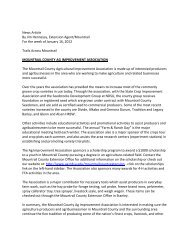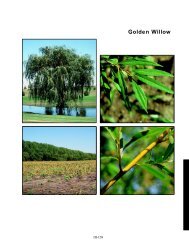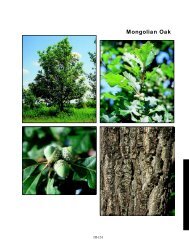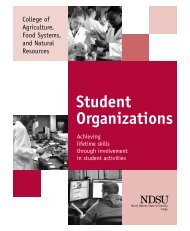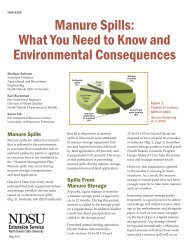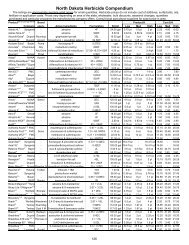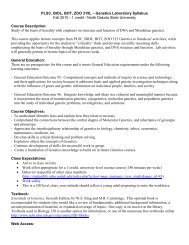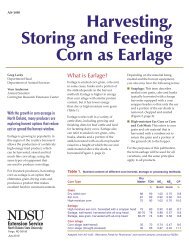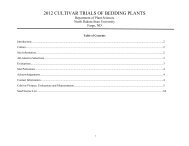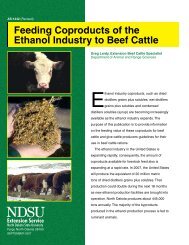NDSU Beef Feedlot - NDSU Agriculture - North Dakota State ...
NDSU Beef Feedlot - NDSU Agriculture - North Dakota State ...
NDSU Beef Feedlot - NDSU Agriculture - North Dakota State ...
Create successful ePaper yourself
Turn your PDF publications into a flip-book with our unique Google optimized e-Paper software.
Table 3. Influence of thiamin and sulfur level on hydrogen sulfide production in<br />
lambs fed a 60% DDGS-based finishing diet.<br />
Day CON LOW MED HIGH<br />
-6 0 0 0 190.6<br />
-4 66.7 0 112.5 25<br />
0 71.5 0 146.9 71.9<br />
3 531.3 375 310.5 737.5<br />
7 778.1 575 759.4 1,237.5<br />
10 2,200.0 a<br />
887.5 b<br />
2,200.0 a<br />
2,453.1 a<br />
14 2,390.6 a<br />
1,087.5 b<br />
1,875.0 a<br />
1,906.3 a<br />
17 2,852.6 a<br />
1,418.8 b<br />
2,609.4 a<br />
21 3,312.5 a<br />
1,531.3 c<br />
2,328.1 abc<br />
24 2,062.5 a<br />
3,287.5 b<br />
3,275.0 b<br />
4,991.6 c<br />
28 4,687.5 a<br />
2,662.5 b<br />
2,906.3 b<br />
6,657.8 c<br />
31 5,687.5 a<br />
2,650.0 b<br />
Treatment 1,2<br />
3,843.8 c<br />
2,406.3 ab<br />
1,958.2 bc<br />
7,701.3 d<br />
abc Means with different superscripts within a row differ at P < 0.10.<br />
Page 14 2009 <strong>NDSU</strong> <strong>Beef</strong> <strong>Feedlot</strong> Research Report<br />
HIGH+S<br />
75<br />
28.1<br />
93.8<br />
475<br />
1,350.0<br />
2,378.1 a<br />
2,015.6 a<br />
2,406.3 ab<br />
3,140.6 ab<br />
3,046.9 ab<br />
4,390.6 a<br />
4,859.4 ac<br />
1 Treatments: CON (no supplemental thiamin), LOW (50 mg·hd -1 ·d -1 thiamin), MED (100<br />
mg·hd -1 ·d -1 thiamin), HIGH (150 mg·hd -1 ·d -1 thiamin) and HIGH+S (150 mg·hd -1 ·d -1 thiamin<br />
with 0.87% S).<br />
2 When tube measurement was below 100 ppm, tube was considered to read 0.<br />
While the hydrogen sulfide concentrations in the lambs did not reach the levels in steers reported by<br />
Niles et al. (2002), the peak concentrations were above those reported by Loneragan et al. (2005); both<br />
of these studies had steers with positive cases of PEM. These results indicate that the concentration of<br />
H2S required to cause symptoms of PEM may vary depending on species.<br />
Of further interest is the way the H2S concentration in lambs fed HIGH+S changed during adaptation.<br />
Specifically, on days 7, 14 and 21, the concentration of H2S was greater in HIGH+S than HIGH;<br />
however, after three days of adaptation (days 10, 17, 24) the concentration of ruminal H2S from<br />
HIGH+S was lower or equal to that found in HIGH fed lambs.<br />
Multiple factors influence the conversion of dietary S into H2S in the rumen during adaptation. Among<br />
these are decreases in ruminal fluid pH, increases in the proportion of sulfur-reducing bacteria and<br />
increases in dietary S. In this study, ruminal pH did not differ among treatments (P = 0.13) at any time<br />
point (data not shown). Lambs fed CON and MED were not different from day 0 throughout sampling<br />
(P > 0.18). However, ruminal pH of LOW, HIGH and HIGH+S groups did decrease (P < 0.03) through<br />
time. Decreases in ruminal pH also may impact incidence of PEM by other means.<br />
Our research suggests that thiamin may influence ruminal H2S concentrations, but we did not<br />
investigate the fate of the H2S. Further, our data suggests that changes in ruminal hydrogen sulfide<br />
concentration cannot be attributed solely to ruminal pH and likely are affected by multiple factors that<br />
interact within the ruminal environment and in the animal.



